英语语法大攻克--介词、连词考点集汇,讲解和训练
英语语法介词连词
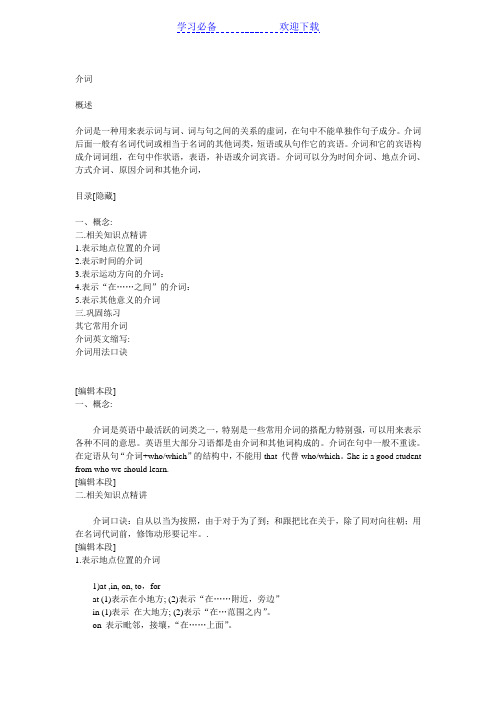
介词概述介词是一种用来表示词与词、词与句之间的关系的虚词,在句中不能单独作句子成分。
介词后面一般有名词代词或相当于名词的其他词类,短语或从句作它的宾语。
介词和它的宾语构成介词词组,在句中作状语,表语,补语或介词宾语。
介词可以分为时间介词、地点介词、方式介词、原因介词和其他介词,目录[隐藏]一、概念:二.相关知识点精讲1.表示地点位置的介词2.表示时间的介词3.表示运动方向的介词:4.表示“在……之间”的介词:5.表示其他意义的介词三.巩固练习其它常用介词介词英文缩写:介词用法口诀[编辑本段]一、概念:介词是英语中最活跃的词类之一,特别是一些常用介词的搭配力特别强,可以用来表示各种不同的意思。
英语里大部分习语都是由介词和其他词构成的。
介词在句中一般不重读。
在定语从句“介词+who/which”的结构中,不能用that 代替who/which。
She is a good student from who we should learn.[编辑本段]二.相关知识点精讲介词口诀:自从以当为按照,由于对于为了到;和跟把比在关于,除了同对向往朝;用在名词代词前,修饰动形要记牢。
.[编辑本段]1.表示地点位置的介词1)at ,in, on, to,forat (1)表示在小地方; (2)表示“在……附近,旁边”in (1)表示在大地方; (2)表示“在…范围之内”。
on 表示毗邻,接壤,“在……上面”。
to 表示在……范围外,不强调是否接壤;或“到……”2)above, over, on 在……上above 指在……上方,不强调是否垂直,与below相对;over指垂直的上方,与under相对,但over与物体有一定的空间,不直接接触。
on表示某物体上面并与之接触。
The bird is flying above my head.There is a bridge over the river.He put his watch on the desk.3)below, under 在……下面under表示在…正下方below表示在……下,不一定在正下方There is a cat under the table.Please write your name below the line.4)in front [frant]of, in the front of在……前面in front of…意思是“在……前面”,指甲物在乙物之前,两者互不包括;其反义词是behind (在……的后面)。
介词连词知识点归纳总结

介词连词知识点归纳总结一、介词介词是一种词类,用来介示名词或代词与其他词的关系。
介词一般位于名词或代词之前,对名词或代词进行修饰或衔接其他成分。
正确使用介词可以使句子的逻辑关系更加清晰。
常见的介词有:at, in, on, for, to, with, by, from, of, between等。
1. 介词的基本用法介词通常用来表示时间、地点、方向、原因、目的、方式等概念。
例如:- 时间:at 7 o'clock, in the morning, on Saturday- 地点:at home, in the park, on the table- 方向:to the store, towards the river, from the mountain- 原因:because of the rain, due to the accident- 目的:for the party, to buy some food- 方式:by car, with my friends2. 介词的固定搭配有些介词与特定的动词、名词或形容词搭配在一起,构成固定的短语或习惯用语。
例如:- 想象介词+名词:afraid of, interested in- 动词+介词:listen to, look at- 形容词+介词:proud of, similar to3. 介词的错误使用在使用介词时,注意避免以下常见错误:- 介词搭配不当:错误的介词搭配会导致句子语义不清或不通顺。
- 介词省略不当:在一些固定搭配中,介词不可省略,否则会影响句子的语法和意义。
- 介词前置不当:介词应当紧跟在名词或代词之后,不可跟在动词的后面。
二、连词连词是一种词类,用来连接句子的不同部分,使句子结构更加清晰和连贯。
连词可以连接并列成分,引导从句,表达因果关系等。
常见的连词有:and, but, or, for, yet, so, because, although, while, as等。
英语语法复习专题五——介词和连词
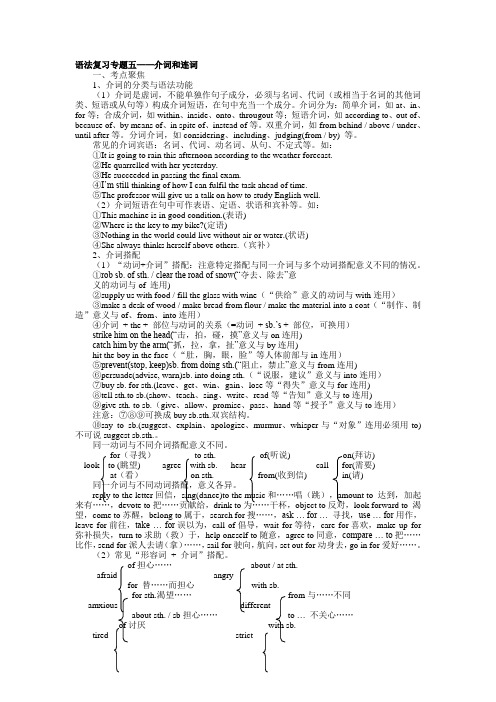
语法复习专题五——介词和连词一、考点聚焦1、介词的分类与语法功能(1)介词是虚词,不能单独作句子成分,必须与名词、代词(或相当于名词的其他词类、短语或从句等)构成介词短语,在句中充当一个成分。
介词分为:简单介词,如at、in、for等;合成介词,如within、inside、onto、througout等;短语介词,如according to、out of、because of、by means of、in spite of、instead of等。
双重介词,如from behind / above / under、until after等。
分词介词,如considering、including、judging(from / by) 等。
常见的介词宾语:名词、代词、动名词、从句、不定式等。
如:①It is going to rain this afternoon according to the weather forecast.②He quarrelled with her yesterday.③He succeeded in passing the final exam.④I’m sti ll thinking of how I can fulfil the task ahead of time.⑤The professor will give us a talk on how to study English well.(2)介词短语在句中可作表语、定语、状语和宾补等。
如:①This machine is in good condition.(表语)②Where is the key to my bike?(定语)③Nothing in the world could live without air or water.(状语)④She always thinks herself above others.(宾补)2、介词搭配(1)“动词+介词”搭配:注意特定搭配与同一介词与多个动词搭配意义不同的情况。
2022高考英语语法--介词连词讲解及习题(附答案)
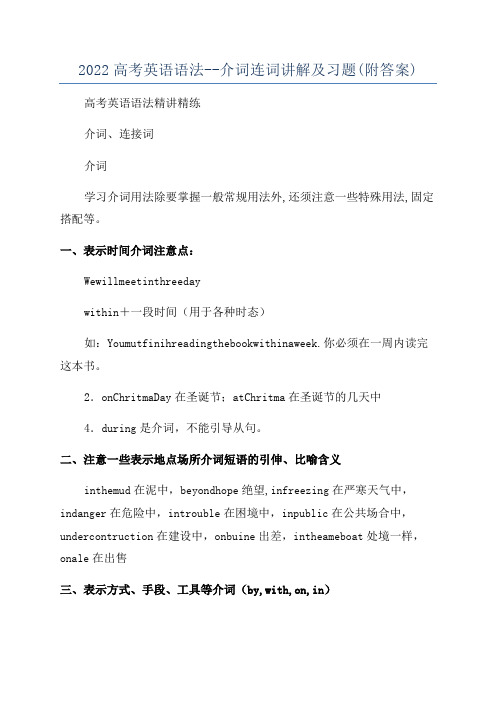
2022高考英语语法--介词连词讲解及习题(附答案)高考英语语法精讲精练介词、连接词介词学习介词用法除要掌握一般常规用法外,还须注意一些特殊用法,固定搭配等。
一、表示时间介词注意点:Wewillmeetinthreedaywithin+一段时间(用于各种时态)如:Youmutfinihreadingthebookwithinaweek.你必须在一周内读完这本书。
2.onChritmaDay在圣诞节;atChritma在圣诞节的几天中4.during是介词,不能引导从句。
二、注意一些表示地点场所介词短语的引伸、比喻含义inthemud在泥中,beyondhope绝望,infreezing在严寒天气中,indanger在危险中,introuble在困境中,inpublic在公共场合中,undercontruction在建设中,onbuine出差,intheameboat处境一样,onale在出售三、表示方式、手段、工具等介词(by,with,on,in)1.by:Theblindmenthoughttheycouldlearnwhattheelephantlookedli kebytouchingit./makealivingbyteaching/byhand手工地,靠手工地,byletter,bypot,byelectricity,learnth.byheart,truckbythebeauty因美丽而着迷Hewapaidbythehour/theday/month/…他按时/日/月/…被付给工钱。
byplane/train/hip/air/water/ea/…,bymeanof用…手段,方式;bywayof经由,取道于…learnEnglihby/over/throug h/ontheradio2.on:liveonfood,kneelonone¢knee,lie/leeponone¢back/ide/face 仰/侧/俯卧(睡)3.in:inEnglih,inink,inilence,inonevoice异口同声地,inahurry 匆忙地,inurprie惊讶地4.with:writewithapen,workwithone¢hand,mellwithone¢noe,beatt hehorewithawhip(鞭子)四、相近介词(短语)辨析about“关于”,知识性或随便谈论:adicuionabouttheplan3.over在…正上方,under在…正下方above在…上面(不一定垂直上方),below在…下面4.inanhour一小时后,用于将来时afteranhour一小时后,用于过去时5.beide在…旁边beide除…之外(还有)e某cept除…之外e某ceptfor除(非同类事物)之外6.on/inthetreetat50DongfengRoad在东风路50号高考英语语法精讲精练7.aholeinthewallapictureonthewallapieceofnewinthenewpaperthewordintheenvelopthemonkeyinthetreetheappleonthetree(树上的苹果。
初中英语语法连词讲解及练习
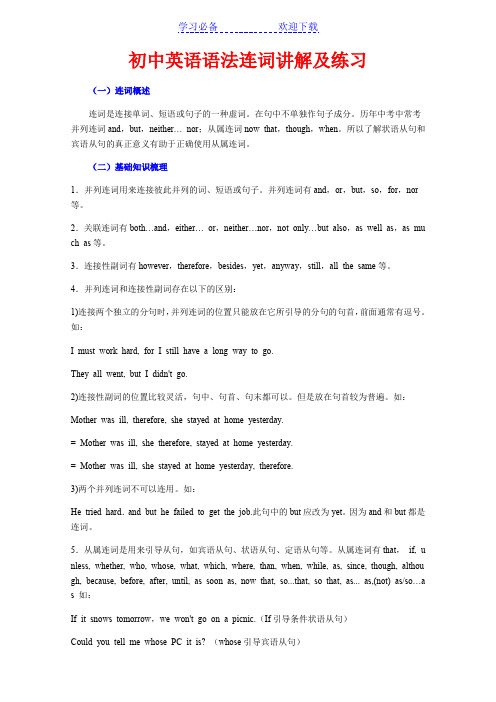
初中英语语法连词讲解及练习(一)连词概述连词是连接单词、短语或句子的一种虚词。
在句中不单独作句子成分。
历年中考中常考并列连词and,but,neither… nor;从属连词now that,though,when。
所以了解状语从句和宾语从句的真正意义有助于正确使用从属连词。
(二)基础知识梳理1.并列连词用来连接彼此并列的词、短语或句子。
并列连词有and,or,but,so,for,nor 等。
2.关联连词有both…and,either… or,neither…nor,not only…but also,as well as,as mu ch as等。
3.连接性副词有however,therefore,besides,yet,anyway,still,all the same等。
4.并列连词和连接性副词存在以下的区别:1)连接两个独立的分句时,并列连词的位置只能放在它所引导的分句的句首,前面通常有逗号。
如:I must work hard, for I still have a long way to go.They all went, but I didn't go.2)连接性副词的位置比较灵活,句中、句首、句末都可以。
但是放在句首较为普遍。
如:Mother was ill, therefore, she stayed at home yesterday.= Mother was ill, she therefore, stayed at home yesterday.= Mother was ill, she stayed at home yesterday, therefore.3)两个并列连词不可以连用。
如:He tried hard.and but he failed to get the job.此句中的but应改为yet。
因为and和but都是连词。
5.从属连词是用来引导从句,如宾语从句、状语从句、定语从句等。
中考英语语法考点突破训练介词和连词含解析

介词和连词考点一、常用介词的种类及意义介词是一种用来表示词与词、词与句之间的关系的虚词,后面一般有名词、代词或相当于名词的其他词类,短语或从句作它的宾语。
1.表示地点位置的介词2.表示时间的介词3.表示运动方向的 介词4.表示“在……之间”的介词:5.表示其他意义的介词考点二、常用连词的种类及意义连词,是一种虚词,不能担任一个句子成分,但可以连接词与词或句与句。
连词有两类:1)从属连词:引导从句。
随着从句作用不同,它们又可分为几类:此外还有that, whether 等从属连词可引导名词从句,在句中担任主语、宾语等。
2)并列连词:连接两个互不依从的次、短语或分句:并列连词有下面几类:一、单项填空(保留15个)1. —Hi, Helen. When were you born?—I was born February, 2003.I’m 15 years old.A. onB.inC.atD.by2. Don’t stay inside such a sunny morning. Let’s go out to enjoy th e gentle wind and the sweet flowers.A. onB. inC. fromD. at3. When H7N9 bird flu first appeared, people didn’t know doctors could cure it.A. ifB. thatC. whatD. why4. —Hurry up, you will miss the school bus.—I know that, Mum. I’ll be ready in a minute.A. butB. andC. soD. or5. Without her glasses, she was blind.A. as far asB. as much asC. as good asD. as well as6. you study harder, you’ll fall behind others.A. OnceB. UnlessC. UntilD. If7. Li Na is famous all the tennis fans in China know her.A. too; toB. enough; toC. as; asD. so; that8. Students here often do physics experiments small groups.A.byB.inC. forD.at9. The program I’m a singer is quite popular students these days. They often talk aboutit between classes.A. forB. withC. in10. In the picture, he sits me, looking very happy.A. besideB. amongC. upD. through11. Stephen Hawking was famous a scientist, he made a great contribution to the world, and he diedMarch 14th, 2018.A. for; onB. as; inC. as; onD.at; in12.Our class are much sure to win the basketball game Class Three.A. ofB.inC. againstD. from13. —Who is the space scientist from Beijing?—The man white over there. He’s of medium height.A. withB. inC. orD. for14. I always play basketball to relax myself Saturdays.A. onB.inC.atD.by15. The program I’m a singer is quite popular students these days. They often talk aboutit between classes.A. forB. withC. inD. of二、用所给的介词填空1. Happy birthday, Peter! Here’s a gift ______ (for/ in)you.2.I’ve ordered some flowers for grandma and they will arrive ______ (in/after)two hours.3.Blue whales are ______(in public/in danger).We should try to protect them.4. —I’m thirsty.I’d like a glass of orange juice.What about you, Andy?—I prefer a cup of tea ______(with/without)nothing in it.5.Most of the villagers took part in the races__(at/in) 9:00 a.m.__(on;in) the morning of June 18.6. —Bill, did you see Tom?—Yes, he just parked his car here and then hurried______(through/across) the street.7. Don’t stay inside.____(on/from) such a sunny morning.Let’s go out to enjoy the gentle wind and the sweet flowers.8. Our class are much sure to win the basketball game (of/against)Class Three.9. —Excuse me, could you please tell me how to get to the Concert Hall?—Sure. Go down the street, and you’ll find it (opposite/near) the Book City.10. More and more people in Qingdao go to work (with/by)subway now.三、用所给的连词填空1. My grandpa learns English for two hours every day, (although/since)he is over 70. Really?We should learn from him.2. My father wants me to be a doctor (and/or)an engineer, (so/but)I want to be an actor.3. ________(Both/Not only)the students _______(but also/and)their English teacher likes watchingfootball games. They often play football after school, too4. Rick has learned a lot about Chinese culture (until/since) he came to China.5. This is new TV set,____ (but/or) I don’t like it.6. Mother wants to spend some time chatting with me _____( but/so) she is very busy every day.7. My parents want me to get further study to be ____(neither/either)an engineer____(nor/or) ascientist, ____(and/but) I would like to be a famous surgeon doctor.8. —Mike, please turn down the music; ___(both/neither) Lucy ____ (nor/and) Lily are sleeping.—Sorry, I’ll do it right away.9. —Would you like to go to the cinema with us?—It sounds like fun, ______(or/but)I’m too busy.10. —Why do you like going to Kunming for a holiday?—Because the weather there is ____(either/neither)too hot _____(or/nor) too cold.四、词语运用阅读短文,从方框中选择适当的词并用其正确形式填空,使短文通顺、意思完整,每空限填一词,每词限用一次。
介词连词知识点总结
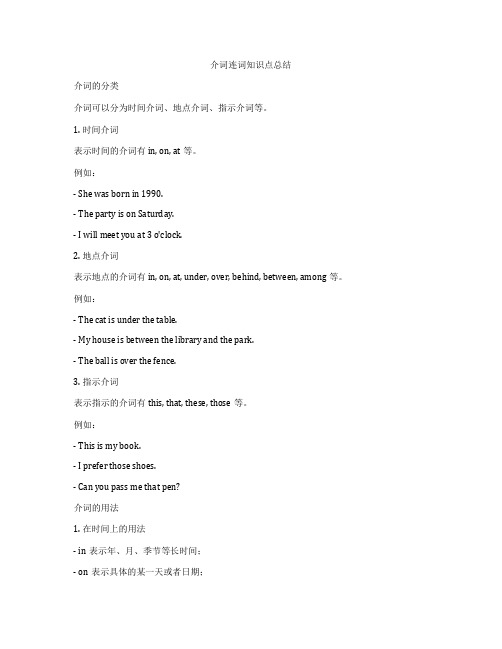
介词连词知识点总结介词的分类介词可以分为时间介词、地点介词、指示介词等。
1. 时间介词表示时间的介词有in, on, at等。
例如:- She was born in 1990.- The party is on Saturday.- I will meet you at 3 o'clock.2. 地点介词表示地点的介词有in, on, at, under, over, behind, between, among等。
例如:- The cat is under the table.- My house is between the library and the park.- The ball is over the fence.3. 指示介词表示指示的介词有this, that, these, those等。
例如:- This is my book.- I prefer those shoes.- Can you pass me that pen?介词的用法1. 在时间上的用法- in表示年、月、季节等长时间;- on表示具体的某一天或者日期;- at表示具体的时刻或某一时间段内。
例如:- She was born in 1990.- The meeting is on Wednesday.- Let's meet at 3 o'clock.2. 在地点上的用法- in表示在某个范围内;- on表示在某个表面或平台上;- at表示在某个具体的地点。
例如:- The cat is in the garden.- The book is on the table.- I will meet you at the station.3. 在方式、原因或目的上的用法- by表示动作的方式或者手段;- for表示目的或者原因。
例如:- I go to school by bus.- She bought a cake for her mother's birthday.介词的连词连词是用来连接词、短语、句子或句子成分的虚词,主要有并列连词、从属连词、副词连词等。
介词连词知识点总结归纳

介词连词知识点总结归纳一、介词的基本概念介词(Prepositions)是一种词类,它通常用来连接名词、代词、动名词或从句等成分,表示时间、地点、方向、原因、目的等关系。
英语中常见的介词有:on, in, at, to, for, with, by, from, into, out of, between, among, through等。
1. 表示时间关系的介词on:表示某一天、日期、时间点等。
in:表示较长的时间段,季节、年代等。
at:表示具体的时间点、场所、节日等。
例句:I will meet you at the corner of the street at 3 o'clock.I was born in 1990.She always goes to school on foot.2. 表示地点关系的介词in:表示某个大的范围或容器内。
on:表示某个平面或表面上。
at:表示某个具体点或目标。
例句:The book is in the drawer.There is a cat on the roof.She is waiting at the bus stop.3. 表示方向关系的介词to:表示朝着某个目标或方向。
from:表示从某个地点或方向出发。
into:表示朝着某个范围或内部。
例句:He walked to the park.I come from China.She poured the water into the glass.4. 表示原因和目的的介词for:表示给予或用于某种目的。
with:表示陪伴或使用某种手段。
例句:I bought a gift for my friend.She cut the cake with a knife.5. 表示关系的介词between:表示在两者或多者之间的关系。
among:表示在多个之中的关系。
through:表示穿过或通过某个范围。
中考英语总复习介词、连词(讲解+练习)

介词和连词中考命题趋向考纲解读 (介词和连词在近 5 年考试中的考察点 )1.熟习和掌握常用介词和连词的用法。
2.认识和运用一些常有的介词短语及连词的使用方法。
3.能正确划分并列连词和附属连词,并掌握其用法。
命题展望1.介词的考察方式以单项选择的形式为主,也会在单词拼写、完形填空中进行考察。
2.据统计,介词的常考点有:(1)表示时间的介词,如:2019·临沂,17 题;2019·咸宁,30 题。
(2)表示地址方向的常用介词,如:2019·大庆,2 题。
(3)表示方式、手段或工具的介词,如:2019·云南,21 题。
(4)介词的常有搭配,如: 2019 ·徐州, 7 题。
连词的考点有:(1)并列连词的用法,如:2019·绥化,6 题;2019·临沂,28 题。
(2)附属连词的用法,如: 2019·长春, 13 题; 2019·乐山,30题。
3.估计此后中考取介词考察的要点将是其基本用法 (同时也要注意介词的常有搭配的状况 );连词的考察将以并列连词和附属连词基本含义为要点,也要注意考察连词的特别用法,比方:“就近原则”,不可以出此刻同一个句子中的连词等。
介词知识点全览介时间介词in,on,at,after,before,since,until ,by,during方向介词词方式介词常有易混杂介词常用介词搭配中考考点清单调、介词概括:等in,on,over,under,above,below,by,beside,near,next to,round/around,between, among,into ,out of 等by,in,on (表示交通方式 ) by,in,with ,on(表示工具或手段等 )during 与 for;before 与 by;across,through,over与 past;in,on 与 to;because,as 与 for;besides与 except介词与动词: listen to 等介词与名词: on time 等介词与形容词: be afraid of 等介词又叫前置词,是一种虚词。
初中英语知识点归纳连词和介词整理

初中英语知识点归纳连词和介词整理初中英语知识点归纳:连词和介词整理英语语法中的连词和介词是我们学习英语的重要组成部分。
它们在句子中起到连接成分、标示关系以及表达逻辑等作用。
本文将为大家整理一些常用的连词和介词,并对其用法和注意事项进行详细解析。
一、连词1. 并列连词(Coordinating Conjunctions)并列连词用于连接同等重要的词、短语、从句或句子,使它们在句子中并列。
常用的并列连词有:and、but、or、so等。
例句:- I like apples and bananas.- He wanted to go to the party, but he was too tired.- You can choose either the red one or the blue one.2. 从属连词(Subordinating Conjunctions)从属连词用于连接主从复合句,将主句和从句进行关联。
常用的从属连词有:because、since、while、if、although等。
例句:- I couldn't go to the concert because I had a lot of homework.- Since it was raining, I stayed at home.- While she was studying, her brother was watching TV.3. 连接副词(Conjunctive Adverbs)连接副词既可以连接句子,也可以连接词、短语和从句。
它们在句子中起到连接的作用,并且常常用来表达转折、递进、因果关系等。
常用的连接副词有:however、therefore、meanwhile、moreover等。
例句:- He studied hard; however, he didn't pass the exam.- She loves playing basketball; moreover, she is very talented at it.- I have a lot of work to do; therefore, I cannot go to the party.二、介词介词是连接名词、代词或者动词与其他成分的词,常常用来表达位置、时间、方式等概念。
必备语法知识归纳介词与连词的用法

必备语法知识归纳介词与连词的用法必备语法知识归纳:介词与连词的用法介词是用来表达事物之间方位、时间、原因、目的、手段、方式等关系的词语。
在英语中,介词的用法非常重要,它能够帮助我们准确地表达自己的意思。
同时,连词也起到连接句子与句子、词与词等作用,使语言更加流畅。
本文将为大家归纳介词与连词的用法,并给出一些例句加以说明。
一、介词的用法1. 表示方位和位置关系:- in:在某个范围内e.g. He is in the room.他在房间里。
- on:在某个表面或平面上e.g. The book is on the table.书在桌子上。
- at:在某个点或地方e.g. We will meet at the park.我们将在公园见面。
2. 表示时间关系:- at:在某个具体时间点e.g. I will arrive at 8 o'clock.我将在8点钟到达。
- on:在某个具体日期或星期几e.g. My birthday is on February 14th.我的生日是在2月14日。
- in:在某个时间段或年份e.g. I will go on vacation in the summer.我会在夏天去度假。
3. 表示原因、目的、手段和方式:- for:表示目的e.g. I study hard for a better future.我努力学习是为了更好的未来。
- by:表示手段或方法e.g. I sent the letter by mail.我通过邮寄发送了信件。
- with:表示伴随或方式e.g. She walks with confidence.她步履自信地走着。
4. 表示从属或归属关系:- of:表示所属关系e.g. The book is the property of the library.这本书是图书馆的财产。
- to:表示从属关系e.g. He is a loyal servant to the king.他是国王的忠诚仆人。
初中英语知识点归纳连词和介词总结

初中英语知识点归纳连词和介词总结初中英语知识点归纳:连词和介词总结在初中英语学习中,连词和介词是非常重要的语法知识点。
它们在句子中起到连接词句和短语的作用,使句子更加流畅和连贯。
本文将对初中英语知识点中的连词和介词进行总结和归纳。
一、连词(Conjunction)连词是连接词句和短语的词语,分为并列连词、从属连词和连词短语。
1.1 并列连词(Coordinating Conjunctions):并列连词用于连接两个平等的词句、短语或句子,常见的并列连词有:1)and(和):表示并列关系,连接同类词或句子。
例如:I like swimming and playing football.我喜欢游泳和踢足球。
2)but(但是):表示转折关系,连接相对立的内容。
例如:She is smart but lazy.她聪明但是懒惰。
3)or(或者):表示选择关系,连接两个或多个选项。
例如:Do you want tea or coffee?你想要茶还是咖啡?1.2 从属连词(Subordinating Conjunctions):从属连词用于连接主从句,引导从句表达因果、时间、条件、目的、方式等关系。
常见的从属连词有:1)because(因为):表示原因或原因结果。
例如:He failed the exam because he didn't study hard.他考试没及格,因为他没好好学习。
2)when(当):表示时间关系,引导时间状语从句。
例如:He called me when he arrived at home.他到家后给我打电话。
3)if(如果):表示条件关系,引导条件状语从句。
例如:If it rains, we will stay at home.如果下雨,我们会呆在家里。
1.3 连词短语(Conjunctive Phrases):连词短语是由两个或多个词组成的短语,起到连接上下文的作用。
(完整版)初中英语语法介词用法讲解与练习
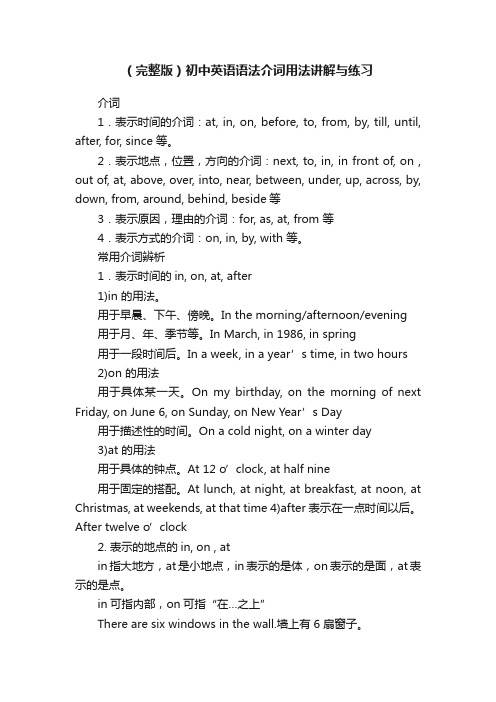
(完整版)初中英语语法介词用法讲解与练习介词1.表示时间的介词:at, in, on, before, to, from, by, till, until, after, for, since 等。
2.表示地点,位置,方向的介词:next, to, in, in front of, on , out of, at, above, over, into, near, between, under, up, across, by, down, from, around, behind, beside等3.表示原因,理由的介词:for, as, at, from 等4.表示方式的介词:on, in, by, with 等。
常用介词辨析1.表示时间的in, on, at, after1)in 的用法。
用于早晨、下午、傍晚。
In the morning/afternoon/evening用于月、年、季节等。
In March, in 1986, in spring用于一段时间后。
In a week, in a year’s time, in two hours2)on 的用法用于具体某一天。
On my birthday, on the morning of next Friday, on June 6, on Sunday, on New Year’s Day用于描述性的时间。
On a cold night, on a winter day3)at 的用法用于具体的钟点。
At 12 o’clock, at half nine用于固定的搭配。
At lunch, at night, at breakfast, at noon, at Christmas, at weekends, at that time 4)after 表示在一点时间以后。
After twelve o’clock2. 表示的地点的in, on , atin指大地方,at是小地点,in表示的是体,on表示的是面,at表示的是点。
连词介词知识点归纳总结
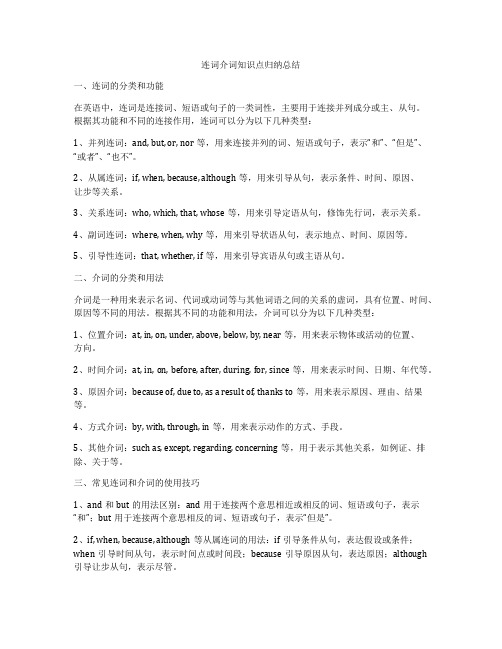
连词介词知识点归纳总结一、连词的分类和功能在英语中,连词是连接词、短语或句子的一类词性,主要用于连接并列成分或主、从句。
根据其功能和不同的连接作用,连词可以分为以下几种类型:1、并列连词:and, but, or, nor等,用来连接并列的词、短语或句子,表示“和”、“但是”、“或者”、“也不”。
2、从属连词:if, when, because, although等,用来引导从句,表示条件、时间、原因、让步等关系。
3、关系连词:who, which, that, whose等,用来引导定语从句,修饰先行词,表示关系。
4、副词连词:where, when, why等,用来引导状语从句,表示地点、时间、原因等。
5、引导性连词:that, whether, if等,用来引导宾语从句或主语从句。
二、介词的分类和用法介词是一种用来表示名词、代词或动词等与其他词语之间的关系的虚词,具有位置、时间、原因等不同的用法。
根据其不同的功能和用法,介词可以分为以下几种类型:1、位置介词:at, in, on, under, above, below, by, near等,用来表示物体或活动的位置、方向。
2、时间介词:at, in, on, before, after, during, for, since等,用来表示时间、日期、年代等。
3、原因介词:because of, due to, as a result of, thanks to等,用来表示原因、理由、结果等。
4、方式介词:by, with, through, in等,用来表示动作的方式、手段。
5、其他介词:such as, except, regarding, concerning等,用于表示其他关系,如例证、排除、关于等。
三、常见连词和介词的使用技巧1、and和but的用法区别:and用于连接两个意思相近或相反的词、短语或句子,表示“和”;but用于连接两个意思相反的词、短语或句子,表示“但是”。
中考英语专题复习资料:介词、连词讲解和训练(精)
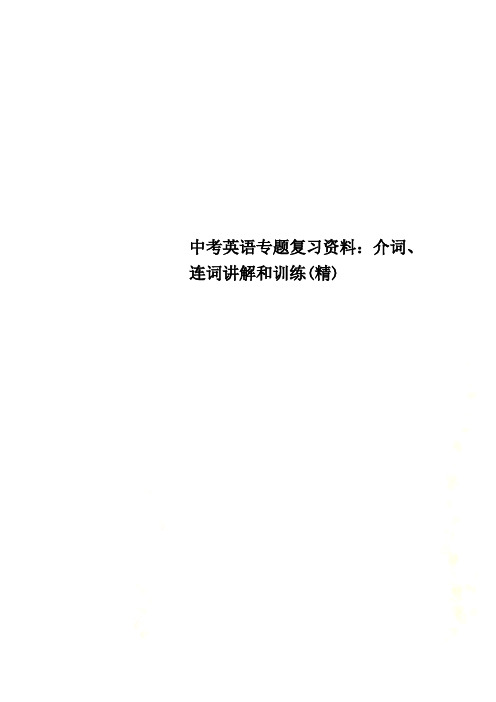
中考英语专题复习资料:介词、连词讲解和训练(精)【考点直击】1. 常用介词及其词组的主要用法和意义;2. 常用动词、形容词与介词、副词的固定搭配及其意义。
3. 并列连词and, but, or, so等的主要用法;4. 常用的从属连词的基本用法【名师点睛】1. 介词的功能介词是一种虚词,用来表示名词或相当于名词的其它词语句中其它词的关系,不能单独使用。
介词可与名词或相当于名词的其它词构成介词短语。
介词短语可在句中作定语,状语,表语和宾语补足语。
例如:The boy over there is John’s brother. (定语The girl will be back in two hours. (状语Our English teacher is from Australia. (表语Help yourself to some fish. (宾语补足语2. 常用介词的用法辨析(1表时间的介词1at, in on表示时间点用at。
例如:at six o’clock, at noon, atmidnight。
表示在某个世纪,某年,某月,某个季节以及早晨,上午,下午,晚上时,用in。
例如:in the ninettenth century, in 2002, in may, in winter, in the morning, in theafternoon等。
表示具体的某一天和某一天的上午,下午,晚上时,用on。
例如:on Monday, on July 1st, on Sunday morning等。
2since, after由since和after引导的词组都可表示从过去某一点开始的时段,但since词组表示的时段一直延续到说话的时刻,因而往往要与现在完成时连用。
而after词组所表示的时段纯系过去,因而要与一般过去时连用。
例如:I haven’t heard from him since last summer.After five days the boy came back.3in, afterin与将来时态连用时,表示“过多长时间以后”的意思,后面跟表示一段时间的词语。
介词、连词讲解及练习

语法系列复习专题-----介词、连接词介词一、表示时间介词注意点:时间介词in、on、at、by、during的用法1.介词in用来表示一天中某段时间,指天、年、月、季节、周次等。
如:in the morningin+一段时间=in+一段时间's time(与将来时连用)如:We'll meetin three days' timewithin+一段时间(用于各种时态)如:You must finish reading the book within a week.你必须在一周内读完这本书。
2.介词on用来表示某一天或星期几,指明具体的时间。
如:on a rainy dayon Christmas Day3.介词at用来表示特定的时间、节日、年龄等。
如:at noon at Christmas4.介词by表示…的时候、到、等到…已经等用在天、时间的前面。
如:by 2 o’clock5.up to now=until now, from morning till night, for the time being暂时,at times有时,day by day一天天地,in no time立刻。
6.during是介词,不能引导从句。
二、注意一些表示地点场所介词短语的引伸、比喻含义in the mud在泥中,beyond hope绝望, in freezing在严寒天气中,in danger在危险中,in trouble在困境中,in public在公共场合中,under construction在建设中,on business出差,in the same boat处境一样,on sale在出售三、表示方式、手段、工具等介词(by,with,on,in)1.by:The blind men thought they could learn what the elephant looked like bytouching it./make a living by teaching/ by hand手工地,靠手工地,by letter,by post, by electricity, learn sth. by heart, struck by the beauty因美丽而着迷by means of用…手段,方式;by way of经由,取道于…learn English by/ over/ through/ on the radioHe was paid by the hour/ the day/ month/…他按时/日/月/…被付给工钱。
知识点介词与连词总结

知识点介词与连词总结介词和连词是语法中常用的重要成分,它们在句子中起到连接、修饰、引导的作用。
在学习英语过程中,掌握常见的介词和连词用法是非常关键的。
下面将总结一些常用的介词和连词,并简要介绍它们的用法。
一、介词1. in介词"in"表示位置、时间或状态。
例如:- He lives in New York.(他住在纽约。
)- We will have a meeting in the afternoon.(我们将在下午开会。
)- She is in a hurry.(她很匆忙。
)2. on介词"on"表示位置、时间或状态。
例如:- The book is on the table.(书在桌子上。
)- My birthday is on July 10th.(我的生日是在7月10日。
)- He is on vacation.(他在度假。
)3. at介词"at"表示时间、地点或位置。
例如:- The party starts at 8 o'clock.(派对在8点开始。
)- They are waiting at the bus stop.(他们在公交车站等候。
)- Please look at the picture.(请看这张图片。
)4. between介词"between"表示两个事物之间的关系。
例如:- The library is between the school and the park.(图书馆在学校和公园之间。
)- Can you choose between these two options?(你能在这两个选项中选择吗?)5. among介词"among"表示三个或更多事物之间的关系。
例如:- The cake is among the desserts on the table.(蛋糕在桌子上的甜点中。
- 1、下载文档前请自行甄别文档内容的完整性,平台不提供额外的编辑、内容补充、找答案等附加服务。
- 2、"仅部分预览"的文档,不可在线预览部分如存在完整性等问题,可反馈申请退款(可完整预览的文档不适用该条件!)。
- 3、如文档侵犯您的权益,请联系客服反馈,我们会尽快为您处理(人工客服工作时间:9:00-18:30)。
复习介词、连词考点集汇,讲解和训练【考点直击】1. 常用介词及其词组的主要用法和意义;2. 常用动词、形容词与介词、副词的固定搭配及其意义。
3. 并列连词and, but, or, so等的主要用法;4. 常用的从属连词的基本用法【名师点睛】1. 介词的功能介词是一种虚词,用来表示名词或相当于名词的其它词语句中其它词的关系,不能单独使用。
介词可与名词或相当于名词的其它词构成介词短语。
介词短语可在句中作定语,状语,表语和宾语补足语。
例如:The boy over there is John’s brother. (定语)The girl will be back in two hours. (状语)Our English teacher is from Australia. (表语)Help yourself to some fish. (宾语补足语)2. 常用介词的用法辨析(1)表时间的介词1)at, in on表示时间点用at。
例如:at six o’clock, at noon, at midnight。
表示在某个世纪,某年,某月,某个季节以及早晨,上午,下午,晚上时,用in。
例如:in the nineteenth century, in 2002, in may, in winter, in the morning, in the afternoon等。
表示具体的某一天和某一天的上午,下午,晚上时,用on。
例如:on Monday, on July 1st, on Sunday morning等。
2)since, after由since和after 引导的词组都可表示从过去某一点开始的时段,但since词组表示的时段一直延续到说话的时刻,因而往往要与现在完成时连用。
而after词组所表示的时段纯系过去,因而要与一般过去时连用。
例如:I haven’t heard from him since last summer.After five days the boy came back.3)in, afterin与将来时态连用时,表示“过多长时间以后”的意思,后面跟表示一段时间的词语。
After 与将来时态连用时,后面只能跟表示时间点的词语。
After与过去时态连用时,后面才能跟表示一段时间的词语。
例如:He will be back in two months.He will arrive after four o’clock.He returned after a month.(2)表示地点的介词1)at, in, onat一般指小地方;in一般指大地方或某个范围之内;on往往表示“在某个物体的表面”。
例如:He arrived in Shanghai yesterday.They arrived at a small village before dark.There is a big hole in the wall.The teacher put up a picture on the wall.2)over, above, onover, on和above都可表示“在……上面”,但具体含义不同。
Over表示位置高于某物,在某物的正上方,其反义词是under。
above也表示位置高于某物,但不一定在正上方,其反义词是below。
On指两个物体表面接触,一个在另一的上面。
例如:There is a bridge over the river.We flew above the clouds.They put some flowers on the teacher’s desk.3)across, throughacross和through均可表示“从这一边到另一边”,但用法不同。
Across的含义与on有关,表示动作在某一物体的表面进行。
Through的含义与in有关,表示动作是在三维空间进行。
例如:The dog ran across the grass.The boy swam across the river.They walked through the forest.I pushed through the crowds.4) in front of, in the front ofin front of 表示“在某人或某物的前面”,在某个范围以外;in the front of 表示“在……的前部”,在某个范围以内。
例如:There are some tall trees in front of the building.The teacher is sitting in the front of the classroom.3. 介词的固定搭配介词往往同其他词类形成了固定搭配关系。
记住这种固定搭配关系,才能正确使用介词。
(1)介词与动词的搭配listen to , laugh at, get to, look for wait for, hear from, turn on, turn off, worry about, think of, look after, spend…on…, 等。
(2)介词与名词的搭配on time, in time, by bus, on foot, with pleasure, on one’s way to, in trouble, at breakfast, at the end of, in the end等。
(3)介词与形容词的搭配be late for, be afraid of, be good at, be interested in, be angry with, be full of, be sorry for等。
4. 连词的功能用来连接词,短语,从句或句子的词叫连词。
连词是一种虚词,在句中不能单独使用。
连词可分为两类:并列连词和从属连词。
5. 并列连词并列连词用来连接具有并列关系的词,短语或句子。
常见的并列连词有:(1)表并列关系的and, both…and, not only…but also, neither…nor等。
(2)表选择关系的or, either…or等。
(3)表转折关系的but, while等。
(4)表因果关系的for, so等。
6. 从属连词从属连词用来引导从句。
常见的从属连词有:(1)引导时间状语从句的after, before, when, while, as, until, till, since, as soon as等。
(2)引导条件状语从句的if, unless等。
(3)引导原因状语从句的because, as, since等。
(4)引导目的状语从句的so that, in order that等。
(5)引导让步状语从句的though, although, even if等。
(6)引导结果状语从句的so that, so…that, such…that等。
(7)引导比较状语从句的than, as…as等。
(8)引导名词从句的that, if , whether等。
7. 常用连词的用法辨析(1)while, when, as这三个连词都可引导时间状语从句,但用法有所不同。
1) 当某事正在进行的时候,又发生了另一件事。
While, when, as 都可用来引导表示“背景”的时间状语从句。
例如:As/When/While I was walking down the street I noticed a police car.2) 当两个长动作同时进行的时候,最常用的是while。
例如:While mother was cooking lunch, I was doing my homework.3) 当两个动作都表示发展变化的情况时,最常用的是as。
例如:As children get older, they become more and more interested in things around them.4) 当两个短动作同时发生时,或表示“一边…一边…”时,最常用as。
例如:Just as he caught the fly, he gave a loud cry.She looked behind from time to time as she went5) 当从句的动作先于主句的动作时,通常用when。
例如:When he finished his work, he took a short rest.6) 当从句是瞬间动作,主句是延续性动作时,通常用when。
例如:When John arrived I was cooking lunch.(2)as, because, since , for这四个词都可表原因,但用法有区别。
1) 如果原因构成句子的最主要部分,一般用because。
因此,because引导的从句往往放在句末。
例如:I stayed at home because it rained.---Why aren’t you going?---Because I don’t want to.2) 如果原因已被人们所知,或不如句子的其它部分重要,就用as或since。
Since比as稍微正式一点。
As和since 引导的从句一般放在句子的开头。
例如:As he wasn’t ready, we left without him.Since I have no money, I can’t buy any food.3) for用来补充说明一种理由,因此,for引导的从句几乎可以放在括号里。
For引导的句子不放在句子的开头。
例如:I decided to stop and have lunch----for I was feeling quite hungry.(3)if, whetherif和whether都可作“是否”讲,在引导宾与从句是一般可互换。
例如:I wonder whether (if) you still study in that school.I don’t know whether (if) he likes that film.在下列情况下,只能用whether,不能用if:1) 引导主语从句时。
例如:Whether he will come to the party is unknown.2) 引导表语从句时。
例如:The question is whether I can pass the exam.3) 在不定式前。
例如:I haven’t made up my mind whether to go there or not.(4)so…that, such...that1) so…that中的so是个副词,其后只能跟形容词或副词,而such...that中的such是个形容词,后接名词或名词短语。
